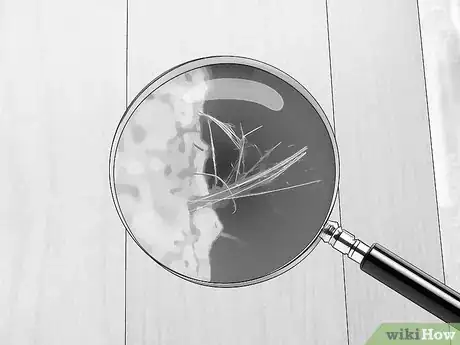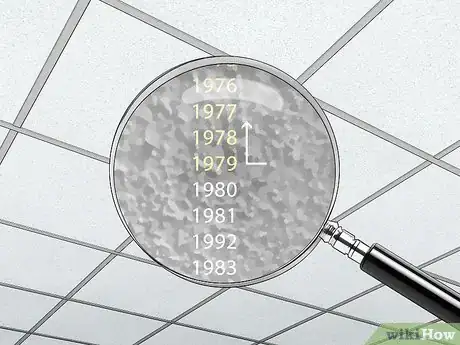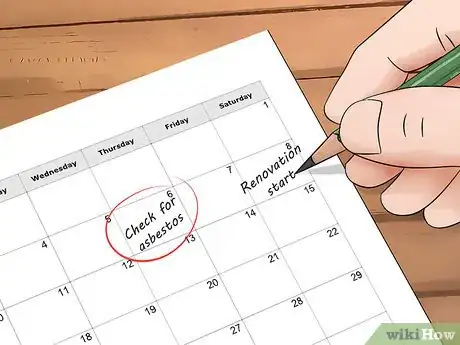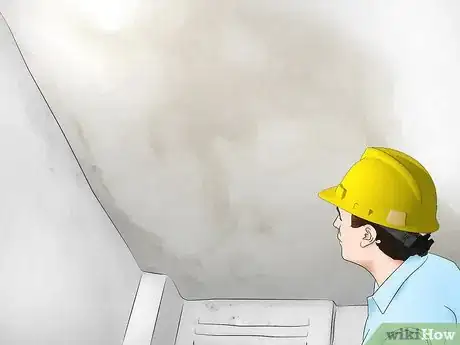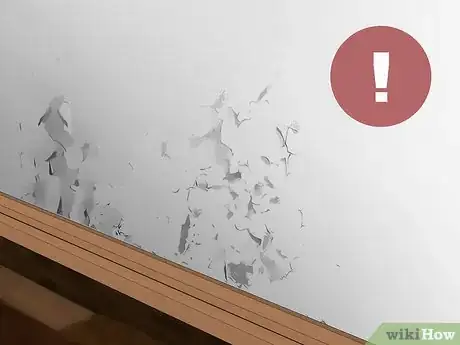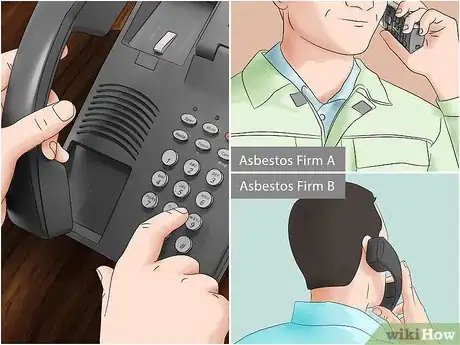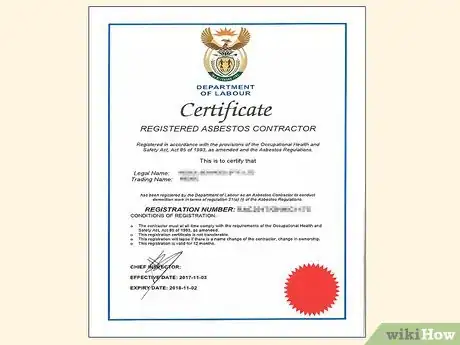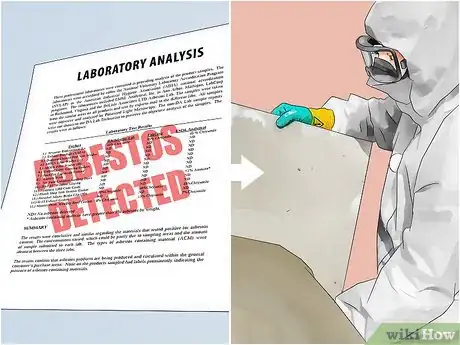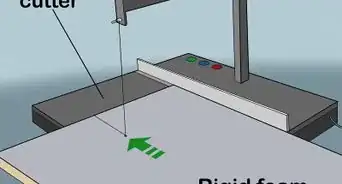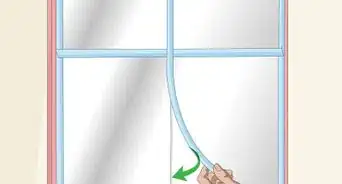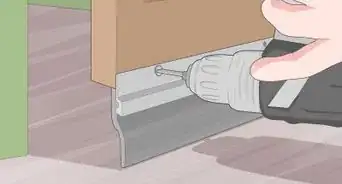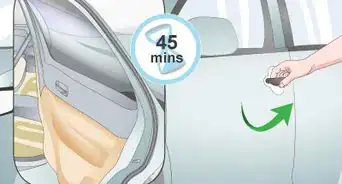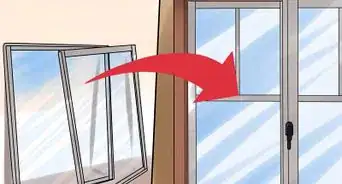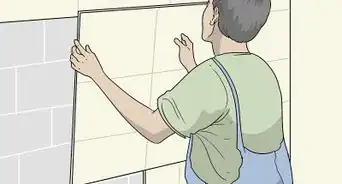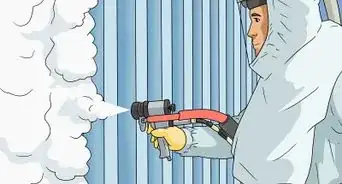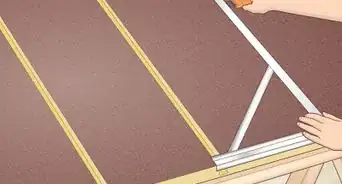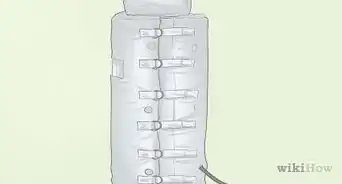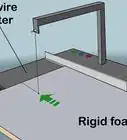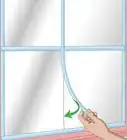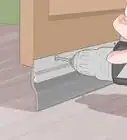This article was co-authored by Gregory Cade, JD. Gregory Cade is an Environmental and Occupational Law Attorney. With over 25 years of experience, he has extensive knowledge in injuries resulting from toxic substance exposure like pesticides. He is a member of numerous professional organizations, including The American Bar Association, The National Association of Environmental Professionals, and The American Association for Justice. Gregory graduated with a BS in Natural Science and Mathematics with an emphasis in Chemistry and Biology and an MPH in Occupational Health, Safety, and Industrial Hygiene from The University of Alabama at Birmingham. He also holds a JD from Miles School of Law.
This article has been viewed 52,466 times.
Asbestos is a naturally occurring mineral composed of thin, needle-like fibers that was once used as a popular building and insulating material. Exposure to asbestos can cause cancer and diseases like mesothelioma. Although asbestos is currently banned as an insulating material in many countries, buildings that were built before 1980 may still contain insulation with asbestos. If you have damaged insulation, you plan to remodel your building, or you suspect your insulation may contain asbestos, you need to contact an asbestos professional that is certified to remove and dispose of the material.
Steps
Recognizing Asbestos Insulation
-
1Look for loose fibers between your walls and in your ceilings. Keep an eye out for light, fluffy fibers that are used as insulation. They could also be found stuffed in paper bags and inserted into floor joists. It could be loose-fill asbestos fiber, and is extremely dangerous. Any disturbance of the fibers could cause them to go airborne and put you at risk of inhaling asbestos.[1]
- If you suspect that you may have loose-fill asbestos fiber, do not try to clean it up. Call an asbestos professional immediately.
- Loose-fill asbestos fiber can be a pale white color, or it could be a darker, dirty color, depending on how old or how dirty it is.
- Look in your attic for loose-fill asbestos.
-
2Check the underside of your roof for a white or gray rough coating. Asbestos spray coating was a commonly used way to insulate a roof and sometimes the sides of buildings. It will look like a rough layer of either white or gray paint. Check the underside of your roof in your attic to see if there is a layer that looks like it was sprayed on.[2]
- It is very easy to overspray asbestos coating, so there may also be some splashback in the area around your roof from when the coating was installed.
- Call an asbestos professional immediately if you think your roof may have asbestos spray coating.
Advertisement -
3Keep an eye out for old wall panel boards and ceiling tiles. Prior to 1980, asbestos insulating board (AIB) was a commonly used material to insulate walls, attics, and ceilings. It’s very difficult to tell if an insulating board contains asbestos because they can come in a variety of sizes, designs, shapes, and colors.[3]
- AIB can be found in partition walls, ceiling tiles, panels below windows, and as fireproofing panels in fire doors.
- If you believe you may have AIB in your building, call a professional to inspect it. Do not try to remove it yourself to bring for testing.
-
4Treat any insulation as if it is asbestos if you’re unsure. Asbestos can be present in almost any type of insulation and can look very different than you may expect. There isn’t necessarily a surefire way to tell if your insulation has asbestos unless it’s labeled or you have an expert take a look. If you’re unsure if your insulation contains asbestos, play it safe and contact a professional to inspect it.[4]
- Do not try to remove insulation that could contain asbestos yourself. There are strict standards regarding the handling and disposal of asbestos.
Warning: Don’t attempt to take a sample of your insulation so you can have it analyzed. Asbestos is very dangerous and can cause serious health complications if you ingest or inhale it.
Knowing When to Inspect for Asbestos Insulation
-
1Inspect for asbestos insulation if you plan to remodel your home. If the building materials in your home or business won’t be disturbed, you don’t need to worry about looking for asbestos. Even if your insulation contains asbestos, if it isn’t disturbed, the asbestos won’t be present in the air to cause any harm. But if you plan to remodel your home, have an asbestos professional inspect your building first.[5]
- Even if you think you’re sure that your building doesn’t contain asbestos insulation, you should still get an inspection if you plan any major remodeling.
-
2Check for asbestos insulation if your home has damage that needs repair. Asbestos insulation is only considered dangerous if it is damaged in some way that could cause the fibers to get released into the air. Before you repair any damage to your building, you need to make sure there isn’t any asbestos present.[6]
- If you have crumbling drywall or your ceiling is falling apart, get an inspection to make sure there isn’t any asbestos in the material.
-
3Look for asbestos in buildings built before 1980. Asbestos was a very popular insulating material from the 1930s to the 1970s. Older buildings, schools, and homes that were built during this time period are likely to contain some material that contains asbestos.[7]
- If you had a home inspection, it’s likely that they did not look for asbestos insulation.
- Knowing when your building was built can also tell you if there are any other potential toxins, like lead, that may be present.
Tip: Access your building information by searching through public records to find out when your building was built.
-
4See if you have crumbling insulation that needs to be replaced. Asbestos can be found in the insulation used in walls, attics, the materials around plumbing and pipes, electrical wiring, as well as on heating and air-conditioning units. If you notice that you have insulation that is falling apart in your building, have a professional inspect for asbestos.[8]
- Insulation that is crumbling or flaking can get into the air and be breathed in by people. If there’s asbestos present in the insulation, it could cause serious harm to anyone who breathes it in.
Getting an Inspection
-
1Use 2 different asbestos firms to avoid a conflict of interest. Hire an asbestos professional to inspect your building and assess your need for repair or removal of asbestos that isn’t tied to a firm that specializes in asbestos removal. They may try to rope you into paying for services that you don’t need.
- Choose 2 firms that aren’t connected to each other or hire a separate inspector to help you decide if you should pay a firm certified to remove asbestos from your building.
- Look online for asbestos removal firms in your area.
-
2Ask the asbestos professional to provide training certifications. When you’re deciding on an asbestos professional or firm to hire, ask them to provide documentation that they completed federal and state-approved training and certifications. Also ask any individuals that a firm may send to provide proof of their certification to perform asbestos-related work.
- Local laws and regulations regarding asbestos removal and disposal can vary, so you need to make sure that the professionals that you hire are following the proper procedures.
-
3Check your local air pollution control board for violations. You can check the past performance of an asbestos professional that you hire by looking at your local air pollution control board and checking with the Better Business Bureau. They should have a record of the firm that you can review to help you make your decision.[9]
- Look for any safety violations reported against them or if any legal actions have been filed against them.
- Call your local air pollution board (sometimes referred to as an air quality department or agency) or go online to search the work history of the firm you intend you hire.
-
4Get a written evaluation from the inspector. When the asbestos professional has finished inspecting or removing asbestos insulation from your building, ask them to provide you with an evaluation of the work they performed. You need to have written assurance from them that all of the proper rules and procedures have been followed.[10]
Warning: You could face potential liability if you cannot provide documentation of asbestos amelioration. Make sure you get written confirmation of the work that was performed!
-
5Schedule an asbestos removal if the inspector finds asbestos. If the asbestos professional identifies asbestos or the lab results confirm that you do in fact have asbestos in your building, contact an asbestos removal firm to schedule an appointment. Avoid using the building until they can remove the asbestos to prevent inhaling the asbestos.[11]
- Use a different firm than the one that you hired to inspect your building to remove the asbestos.
- Be sure to get written verification that the asbestos was removed properly.
Warning
- Do not attempt to handle any insulation that you think could contain asbestos.
- Contact an asbestos professional if you think your insulation may contain asbestos.
References
- ↑ https://www.sciencedaily.com/releases/2017/11/171102091118.htm
- ↑ http://www.hse.gov.uk/asbestos/essentials/sprayed.htm
- ↑ http://www.hse.gov.uk/asbestos/essentials/aib.htm
- ↑ https://www.maacenter.org/asbestos/homes/
- ↑ https://www.epa.gov/asbestos/protect-your-family-exposures-asbestos
- ↑ https://www.epa.gov/asbestos/protect-your-family-exposures-asbestos
- ↑ https://www.maacenter.org/asbestos/homes/
- ↑ https://www.maacenter.org/asbestos/homes/
- ↑ https://www.epa.gov/asbestos/protect-your-family-exposures-asbestos#professionals
